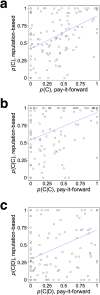Transient nature of cooperation by pay-it-forward reciprocity
- PMID: 26786178
- PMCID: PMC4726336
- DOI: 10.1038/srep19471
Transient nature of cooperation by pay-it-forward reciprocity
Abstract
Humans often forward kindness received from others to strangers, a phenomenon called the upstream or pay-it-forward indirect reciprocity. Some field observations and laboratory experiments found evidence of pay-it-forward reciprocity in which chains of cooperative acts persist in social dilemma situations. Theoretically, however, cooperation based on pay-it-forward reciprocity is not sustainable. We carried out laboratory experiments of a pay-it-forward indirect reciprocity game (i.e., chained gift-giving game) on a large scale in terms of group size and time. We found that cooperation consistent with pay-it-forward reciprocity occurred only in a first few decisions per participant and that cooperation originated from inherent pro-sociality of individuals. In contrast, the same groups of participants showed persisting chains of cooperation in a different indirect reciprocity game in which participants earned reputation by cooperating. Our experimental results suggest that pay-it-forward reciprocity is transient and disappears when a person makes decisions repeatedly, whereas the reputation-based reciprocity is stable in the same situation.
Figures




Similar articles
-
Two distinct neural mechanisms underlying indirect reciprocity.Proc Natl Acad Sci U S A. 2014 Mar 18;111(11):3990-5. doi: 10.1073/pnas.1318570111. Epub 2014 Mar 3. Proc Natl Acad Sci U S A. 2014. PMID: 24591599 Free PMC article.
-
Network homophily and the evolution of the pay-it-forward reciprocity.PLoS One. 2011;6(12):e29188. doi: 10.1371/journal.pone.0029188. Epub 2011 Dec 15. PLoS One. 2011. PMID: 22195019 Free PMC article.
-
Three-person game facilitates indirect reciprocity under image scoring.J Theor Biol. 2007 Nov 7;249(1):93-100. doi: 10.1016/j.jtbi.2007.07.017. Epub 2007 Jul 24. J Theor Biol. 2007. PMID: 17714735
-
Universal scaling for the dilemma strength in evolutionary games.Phys Life Rev. 2015 Sep;14:1-30. doi: 10.1016/j.plrev.2015.04.033. Epub 2015 May 5. Phys Life Rev. 2015. PMID: 25979121 Review.
-
Reputation and reciprocity.Phys Life Rev. 2023 Sep;46:8-45. doi: 10.1016/j.plrev.2023.05.002. Epub 2023 May 10. Phys Life Rev. 2023. PMID: 37244154 Review.
Cited by
-
Social status mediates the propagation of unfairness.Front Psychol. 2024 Sep 9;15:1253831. doi: 10.3389/fpsyg.2024.1253831. eCollection 2024. Front Psychol. 2024. PMID: 39315034 Free PMC article.
-
Exploring new technologies for the future generation: exploration-exploitation trade-off in an intergenerational framework.R Soc Open Sci. 2024 May 1;11(5):231108. doi: 10.1098/rsos.231108. eCollection 2024 May. R Soc Open Sci. 2024. PMID: 38699556 Free PMC article.
-
Individuals reciprocate negative actions revealing negative upstream reciprocity.PLoS One. 2023 Jul 5;18(7):e0288019. doi: 10.1371/journal.pone.0288019. eCollection 2023. PLoS One. 2023. PMID: 37406012 Free PMC article.
-
Behavioral Intention Promotes Generalized Reciprocity: Evidence From the Dictator Game.Front Psychol. 2020 Apr 30;11:772. doi: 10.3389/fpsyg.2020.00772. eCollection 2020. Front Psychol. 2020. PMID: 32425857 Free PMC article.
-
Intergenerational sustainability is enhanced by taking the perspective of future generations.Sci Rep. 2021 Jan 28;11(1):2437. doi: 10.1038/s41598-021-81835-y. Sci Rep. 2021. PMID: 33510203 Free PMC article.
References
-
- Mallough R. An extra-large sized order of generosity. Maclean's (16th January 2013) Available at: http://www.macleans.ca/news/canada/an-extra-large-sized-order-of-generos... (Accessed: 30th April 2015).
-
- Murphy K. Ma’am, your burger has been paid for. The New York Times (19th October 2013) Available at: http://www.nytimes.com/2013/10/20/opinion/sunday/maam-your-burger-has-be... (Accessed: 30th April 2015).
-
- Kim S. Conn. Starbucks Customers Pay it forward 640 times and growing. ABC News (26th December 2013) Available at: http://abcnews.go.com/Business/connecticut-starbucks-customers-reaching-... (Accessed: 30th April 2015).
-
- Cuevas M. Thanks, au lait: 750 pay it forward at Starbucks location. CNN (22nd August 2014) Available at: http://edition.cnn.com/2014/08/21/us/starbucks-pay-it-forward-chain/ (Accessed: 30th April 2015).
-
- Firozi P. 378 people 'pay it forward' at Starbucks. USA Today (21st August 2014) Available at: http://www.usatoday.com/story/news/nation-now/2014/08/21/378-people-pay-... (Accessed: 30th April 2015).
Publication types
MeSH terms
LinkOut - more resources
Full Text Sources
Other Literature Sources
Molecular Biology Databases

